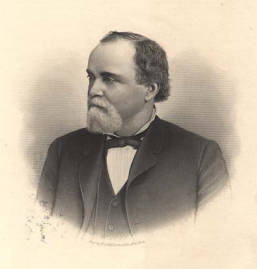Click http://www.alabamapioneers.com/honor-your-ancestor-on-alab…/to see how to honor your ancestor as a Notable Alabama Pioneer
Happy Birthday!

JOHN TURNER MILNER
BIOGRAPHY and GENEALOGY
(1826-1898)
Jefferson County, Alabama
John Turner Milner, civil engineer, was born September 29, 1826, in Pike County, Ga., son of Willis Jay and Mary Ann (Turner) Milner, brother of Willis Julian Milner.
His grandmother on his father’s side was a sister of the Rev. Joshua S. Calloway, who in his lifetime, was one of the most eminent Baptist divines of the State of Georgia.
The Calloways and Milners of Georgia and the Turners of North Carolina were plain, matter-of-fact people.
His early education was limited as he went to school and worked alternately. At the age of ten, he learned his first lessons in mining at his father’s mines in Lumpkin County, Ga.
From his twelfth to his fifteenth year he was engaged in railroad construction under the direction of his father who at that time was a railroad contractor and at the age of seventeen, he entered the gold mines near Dahlonega, Ga. He next entered the University of Georgia but was forced to leave at the end of his third year on account of failing health.
Returning to his home he became interested in civil engineering working under George H. Hazelhurst, the distinguished civil engineer who at that time was engaged on the Macon and Western railroad. In less than two years, Mr. Milner was a principal assistant engineer in the construction of the Muscogee road, now a part of the Columbus and Macon railroad.
In 1842, he drove an ox team across the plains to Oregon and California and in the latter state was appointed by General Riley, the then provisional governor of California, city surveyor of San Jose the capital of the state. He returned to Georgia in 1852 and shortly afterward moved to Alabama where he became connected with the Montgomery and West Point railroad at Chehaw, Macon County.
Governor Moore commissioned him in 1858 under an act of the legislature to survey and locate a railroad line connecting the navigable waters of the Alabama River with those of the Tennessee. He selected and recommended the line upon which the South and North railroad was built.
On November 3, 1858 h,e was elected chief engineer of the South and North railroad company. He continued in this position until October 1 1872 when the railroad was completed and placed under the control of the Louisville and Nashville system at which time he retired from active service. He founded the sawmills at Boiling and projected the great city of Birmingham.
Before Colonel Powell, Josiah Morris or any others thought of such a place he had entered into a written agreement with RC McCalla as the chief engineer and representative of the managers of the Alabama and Chattanooga railroad to buy for their respective companies the land at the crossing of the two roads with the view of building a great industrial city. He purchased about seven thousand acres in Village Creek valley several miles northwest of the present site of Birmingham and extending from a point near Pratt Mines towards the east.
The unwarranted withdrawal of the managers for the Alabama and Chattanooga people from their written agreement thwarted him in his purposes. They changed the location of their line and bought the present site of the city of Birmingham but as a matter of precaution not knowing exactly where Mr M.ilner would cross their line with the South and North they only took sixty day options on the purchases they had made. There was no other available crossing except where Birmingham now is after changing the line from the Village Creek valley to the Elyton valley.
Throughout the sixty days h,e gave no intimation or sign as to where the crossing would be located but had surveys made for crossings at every available point above and below Elyton for miles. At the expiration of the three days of grace allowed in such transactions t,he dropped or forfeited Stanton options covering the site of the great city were taken up and the money paid for them.
Mr M.ilner faithful to the trust confided in him as engineer of the South and North Alabama railroad had arranged for his company to own half of the great city of the future. After the development of the Coalburg coal property near Birmingham h,e sold it in May 1883 to the Georgia Pacific railroad company at a profit of over two thousand dollars. He also developed the New Castle coal property about nine miles east of Birmingham was the owner of valuable property in the city of Birmingham and was sta ockholder in the most important land companies there Author of “Alabama, As It Was, As It Is and As It Will Be”.
He married December 30 1855 to Flora Ida Caldwell, daughter of John C Caldwell of Greenville. They had the following known children:
- Henry Willis Milner (1858-1931)
- Lillian Milner Orr (1862-1942)
- Florence Milner Weatherly (1864-1926)
He died in 1898 and is buried in Oak Hill Cemetery in Birmingham, Jefferson County, Alabama.
SOURCES
- History of Alabama and Dictionary of Alabama Biography, Volume 4 By Thomas McAdory Owen
- Find A Grave.org Memorial # 7026667 # 108464887# 108464705# 15370068# 88107214




[…] address on the life and achievements of Col. John T. Milner, Industrialist, was made by Gen. R. S. Steiner, Col. Milner’s daughter, Mrs. C. P. Orr, […]
Enjoyed the biography of John T.Milner…..and that he owned the Coal Mines in Coalburg,Alabama….that is my home…..
This short history of John T. Milner is thoroughly sanitized. According to Douglas Blackmon (Wall Street Journal and author of “Slavery by Another Name”), “A description of Milner’s mine by The New York Times in December 1882 told of black prisoners (leased from county jails and usually convicted of petty or “non”-crimes) packed into a single cramped cabin like slaves on the Atlantic passage. The building had no windows, Vermin-ridden bunks stacked three high were covered with straw and ‘ravaged blankets.’ ‘Revolting filthy’ food was served cold from unwashed coal bucket and all 150 black convicts shared three half-barrel tubs for washing. All convicts were forced to wear shackles consisting of an ‘iron hoop fastened around the ankle which is attached a chain two feet long and terminating in a ring.'”